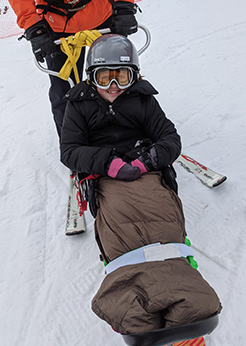What is ZC4H2
Associated Rare Disorders (ZARD)?
ZC4H2 Associated Rare Disorders or ZARD, is an ultra-rare genetic condition with neurologic and neuromuscular involvement. It is caused by mutations (pathogenic variants) of the ZC4H2 gene.
The ZC4H2 gene encodes (“produces”) the ZC4H2 protein which is essential for normal development. The ZC4H2 gene is located on the X chromosome, therefore ZARD is an X-linked condition.
Understanding of the functions of the ZC4H2 gene and the functions of its corresponding ZC4H2 protein is currently limited. It is believed that the ZC4H2 protein plays an important role in the development of the neurologic system during the early stages of human development, particularly through the development of neuromuscular junctions, spinal cord motor-neuron differentiation and neural tube formation.
Sometimes, clinical geneticists call the condition “Wieacker-Wolff Syndrome” or other names, such as “Carpenter-Miles Syndrome”. We consider these previously used names to be partial reports of the condition known as ZARD. The correct diagnosis and name is ZARD.
Boys and girls can both be affected by ZARD and have different symptoms in various severities. ZARD is a spectrum rather than a defined group of symptoms.
Mutations in the ZC4H2 gene can be passed on from a parent to a child (hereditary) or happen spontaneously (‘de-novo’). When the mutation is hereditary, i.e., inherited from a carrier female, the sons are usually affected because males carry only a single X chromosome. In this case, the clinical symptoms of affected males are usually severe, while their carrier female siblings are usually unaffected or much less severely affected.
In de-novo cases -up to now mostly identified in females-, patients show different clinical presentations.
To date, there are 240 diagnosed patients with ZARD worldwide. There are more diagnosed females than males.
There is currently no evidence of any progressive or regressive nature in the condition. Age expectancy is yet undetermined.
The symptoms
Patients with ZARD can have multiple disabilities and health concerns. These can include orthopedic and musculoskeletal conditions and neurological/neuromuscular conditions.
There is a great variation of symptoms and severities in both male and female ZARD patients. An individual patient can present with a few or many symptoms.
The one symptom commonly shared by all patients is
- Motor planning impairments (either localized or generalized)
Symptoms observed in almost all cases to date, in varying severities, include:
- Issues with muscle tone
- Congenital deformities in feet, with a characteristic proximal insertion of the first toe
- Congenital contractures in hands and fingers, with a characteristic proximal insertion of the thumb
- Delayed motor development (mobility)
- Orthopedic problems: including dislocations of hips and knees, bone malalignments or deformities
- Oculomotor apraxia and other ocular conditions
Symptoms present in most patients, in different severities, are:
- Arthrogryposis Multiplex Congenita (AMC): defined as multiple joint contractures that involve at least two different body areas before birth. In ZARD, AMC could be a possible secondary consequence of reduced fetal movement
- Difficulty swallowing, at least early in life
- Respiratory complications at least early in life
- Apraxia of speech
- Spinal complications including tethered spinal cord, scoliosis and kyphosis.
- Delayed cognitive development or learning difficulties
Other symptoms in some patients include:
- Epilepsy
- Cortical visual impairment
- Autism
- GI problems
- Vascular and cardiac problems (reported in males)
- Gonadal disorders (reported in males)
There is currently no cure or effective treatment for ZARD. Current treatments consist mainly of different supportive therapies and medical interventions when necessary. However, from the experience in our community, we observe a correlation between early therapeutic and supportive interventions (in particular pre-verbal and speech as well as physical therapies) and favorable short and long term outcomes.
For medical professionals, additional information about ZARD can be found here. For parents, we highly recommend watching this presentation on the basic science of ZC4H2.

The National Organization for Rare Disorders (NORD) has published a report on ZARD in their Rare Disease Database.





ZC4H2 Research Foundation, Inc. All rights reserved.
ZC4H2 Research Foundation has been recognized by the Internal Revenue Service as a 501(c)(3) organization. EIN: 87-4577599




